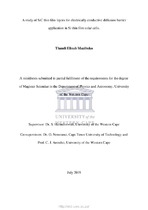A study of SiC thin film layers for electrically conductive diffusion barrier application in Si thin film solar cells.
Abstract
Semiconductor silicon carbide (SiC) thin films of different thicknesses were deposited by
electron beam physical vapour deposition (EBPVD) for application as diffusion barrier
application to guard against metal contaminants in Si silicon solar cells. The deposited films
were implanted with a high and low fluence of 5 × 1016 ions/cm2 and 1 × 1016 ions/cm2;
before implantation stopping of ions in matter (SRIM) software package was used to simulate
an implantation profile. Realtime Rutherford backscattering spectrometry (real-time-RBS)
studies were done on the implanted films ramping from room-temperature (RT) to temperature
of 600 ℃, which was the maximum temperature that the heater in the system used could
achieve, show that Ag was stable until the probed temperature range. Subsequent isochronal
annealing experiments were done for 1 hour at 650 ℃ and 950 ℃. The simulations of RBS
spectra and Energy dispersive X-ray (EDX) spectroscopy results revealed a gradual Ag
decrease in the films with increasing temperature. The broadening and the appearance of new
small peaks on the implantation profile of Ag suggest the onset of the metal diffusion in the
film. Fourier transform infrared (FTIR) spectroscopy studies showed that the width of the SiC
vibration peak at around 800 cm-1 becomes narrower as the temperature is increased,
suggesting a crystallization in SiC; the grain boundaries might thus be the pathway of the
diffusing Ag. Scanning electron microscopy (SEM) micrographs showed a roughening of the
film surface of the same layer in which the onset of diffusion was observed at 850 ℃; this
suggested a crystallization of the film in agreement with FTIR investigation. This temperature
was thus chosen for isothermal annealing studies. As in the case of isochronal annealing, a
gradual decrease and change in the shape of the Ag RBS profile both towards the surface and
to the interface; this was interpreted as in-diffusion and out-diffusion competing mechanisms.

